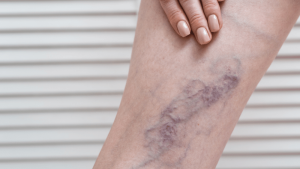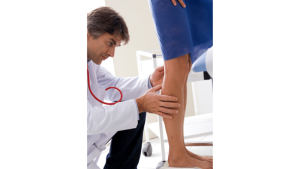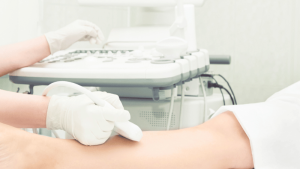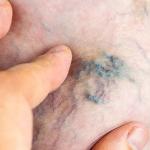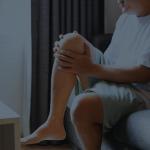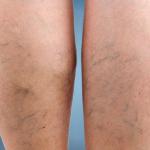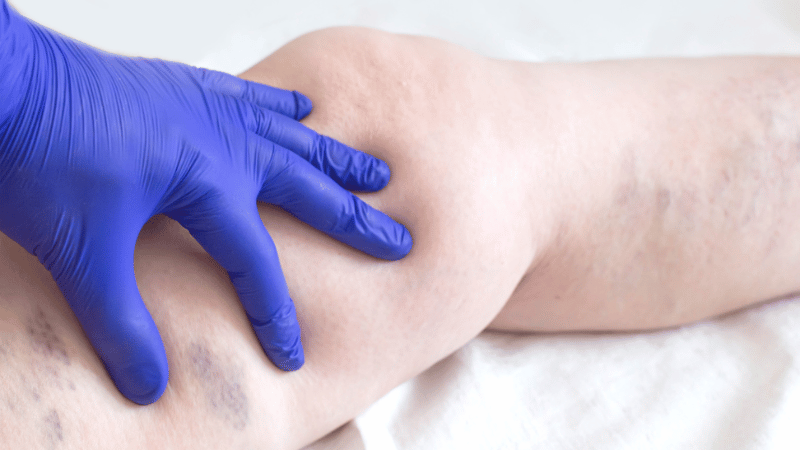
Chronic Venous Insufficiency (CVI) presents a spectrum of visible symptoms that can vary in severity based on the individual. Characterized by impaired blood flow in the veins, CVI often starts with the appearance of spider veins and varicose veins, particularly in the legs. Understanding the visual cues of CVI is crucial for early detection and intervention to preserve vein health and overall well-being.
Chronic venous insufficiency can put you at risk for serious complications, such as deep vein thrombosis (DVI) and venous ulcers. CVI manifests through symptoms like leg swelling, skin changes, and leg pain. By knowing how to recognize the signs of CVI early on, you can take control of your vein health and prevent dangerous health issues from developing in the first place.
This guide covers the signs and symptoms so you know what chronic venous insufficiency looks like and how to recognize a problem. We also explain how to prevent CVI and the best way to protect your vein health.
Stay on Top of Your Vein Health
What Causes Chronic Venous Insufficiency?
Damaged or diseased veins cause chronic venous insufficiency.
Blood moves easily in normal, healthy veins. Valves inside the veins act as one-way doors to keep blood flowing in one direction: towards the heart.
When damaged by inflammation or other causes, the valves stop working properly. As a result, blood can flow backward, putting increased pressure on the walls of these blood vessels.
The walls can become stretched or enlarged. Also, circulation is impacted, leading to symptoms ranging from numbness and tingling to slower healing and a weakened immune system.
Chronic Venous Insufficiency (CVI) Risk Factors
While it’s not clear what causes the vein damage that leads to CVI symptoms, doctors do know what risk factors increase a person’s chances of developing chronic venous insufficiency.
The main risk factors include the following:
- Age. Varicose and spider veins — two of the most common venous insufficiency symptoms — are most common in adults over 50.
- Gender. Women are more likely to have CVI than men because of hormonal changes during everyday life, such as pregnancy and menopause.
- Lifestyle. Factors that increase blood pressure, like smoking, stress, being overweight, and not getting enough exercise, also increase your risk of poor vascular health.
- Family history. If a close relative has varicose veins or other signs of CVI, you’ll likely develop vein problems.
If you’re at a higher risk for chronic venous insufficiency, it’s important to screen for vein health issues, especially if you’re over 50. Our vein doctors provide comprehensive vein checkups/evaluations in clinics nationwide, making it easy to check your vein health.
Signs and Symptoms of Chronic Venous Insufficiency
What does chronic venous insufficiency look like? What signs indicate there’s a problem with your vein health?
Venous insufficiency symptoms range from the appearance of spider veins and varicose veins, painful symptoms to dramatic skin changes. As CVI progresses, these symptoms get worse.
As chronic venous insufficiency progresses, the symptoms can become more pronounced and debilitating. If left untreated, CVI can lead to more severe complications such as skin discoloration, ulcers, and even blood clots. Therefore, it’s essential to address venous insufficiency symptoms early on to prevent further deterioration of vein health and overall well-being.
It’s also important to understand that venous insufficiency won’t go away on its own. You will need treatment to restore your vein health once this condition develops.
Here are the signs and symptoms you should be aware of if you have any risk factors for CVI:
- Spider veins. These are branch-like webs of veins that appear underneath the skin.
- Varicose veins. These are enlarged leg veins that appear twisted or raised above the skin.
- Skin changes. In the early stages of CVI, look for dry, itchy skin, rashes, and open wounds on the legs that are slow to heal.
- Physical symptoms. People with CVI might have leg pain, night cramps, a feeling of heaviness in the legs, or numbness in the legs and feet.
Other possible symptoms include restless legs and issues related to poor circulation, such as cold feet and legs, swelling, and skin discoloration.
Preventing Chronic Venous Insufficiency
Preventing Chronic Venous insufficiency is paramount for maintaining overall health and well-being. CVI can significantly impact one’s quality of life, posing various challenges and discomforts. Beyond the visible symptoms like spider veins and varicose veins, CVI can lead to debilitating pain, swelling, and leg numbness, making simple daily activities more difficult.
The progression of CVI may result in more severe complications such as skin ulcers and increased risk of blood clots, further disrupting daily life and potentially requiring medical intervention. Understanding the negative implications of CVI is crucial for seeking timely treatment and managing its effects on overall well-being
Whether you have one or more risk factors, taking care of your vein health should be a priority. Anyone can develop chronic venous insufficiency. Also, healthy veins are a foundational part of overall wellness — they impact the health of your heart, brain, lungs, and immune system. When your veins stop working properly, blood circulation decreases, impacting the health of your major organs, energy levels, and cognitive functioning.
So what can you do to help prevent chronic venous insufficiency and keep your veins healthy?
Getting plenty of exercise helps. Aim for 30 minutes five days a week. You can walk, swim, do yoga, or move your body in other ways.
Physical activity stimulates the muscles in the legs, aiding in the efficient pumping of blood back to the heart and reducing the risk of blood pooling in the veins. Incorporating a daily exercise routine can significantly contribute to preventing CVI and supporting healthy veins.
A healthy diet keeps vein walls and valves strong and supple. The right foods can also prevent high blood pressure and reduce inflammation in the body.
Eat a high-fiber diet with plenty of antioxidant-rich foods, such as berries, garlic, ginger, and green tea.
You should also see a vein specialist regularly to check for early warning signs of an issue. By spotting CVI early, you can get the treatment you need to restore your vein health.
Schedule a Vein Consultation Online
Diagnosing and Treating Venous Insufficiency
Diagnosing and treating venous insufficiency promptly is essential for managing symptoms and preventing potential complications. Early intervention not only alleviates symptoms but also reduces the risk of further vascular issues, highlighting the importance of seeking medical evaluation if CVI is suspected.
If you suspect you may have CVI, it’s important to communicate your concerns openly with your doctor during routine checkups, discussing any symptoms or changes in vein health to facilitate early diagnosis and appropriate management strategies.
Doctors can diagnose chronic venous insufficiency after examining the veins with medical imaging technology. They use ultrasound vein mapping to identify damaged or diseased veins. They’ll also assess any symptoms, including visible signs of CVI, like varicose veins or skin changes and physical symptoms such as leg swelling, heaviness, or discomfort.
After diagnosing CVI, your doctor will recommend a treatment plan to address the damaged veins based on your specific condition. Treatment will also help to relieve any existing symptoms, including varicose veins, spider veins, leg pain, and skin rashes or venous ulcers.
Traditionally, varicose veins and other issues related to CVI were treated with surgery. However, today, vein specialists treat chronic venous insufficiency with minimally invasive treatments that close or collapse diseased veins. These procedures require minimal downtime and can be performed in an outpatient setting in less than an hour.
Your doctor might also recommend at-home post-treatment measures to support your veins and encourage blood circulation, such as wearing compression stockings and elevating your legs.
Find Out if You Have Chronic Venous Insufficiency
Are you noticing signs of CVI, such as varicose veins, leg swelling, or skin changes? If you’re concerned about your vein health, a vein specialist can examine your legs and give you an accurate diagnosis and treatment plan.
The reality is that vein symptoms indicate an underlying problem with your veins. They also increase your risk for blood clots and venous ulcers, which can lead to dangerous outcomes, including serious infections and even a pulmonary embolism.
It is important to know if you have CVI for your overall well-being.
Request a consultation at a USA Vein Clinics location near you. Our experienced vein doctors will help you get the treatment you need for better vein health.

